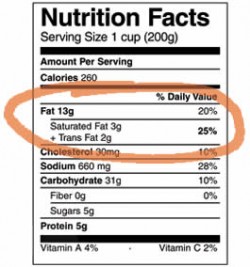
I just stumbled upon a Newsday article that looks at a few pieces of research to in study of fats in our diet. Is a good diet high or low in fat? There is so much conflicting evidence these days but I think this kind of article helps you ask yourself a lot of questions and then it is up to you to decide what to do about it by listening to how your body reacts to different diets.
Confusion – What is a Healthy Diet?
When it comes to defining a healthy diet, and a study of fats in our diet it’s easy to become confused. Recent reports from the Women’s Health Initiative study, which followed 40,000 women for eight years, concluded that low-fat diets and calcium with vitamin D supplements do not decrease a woman’s risk for heart disease, colon cancer, breast cancer or hip fractures. Upon hearing this news, after being schooled for years on the merits of low-fat diets and calcium, a health-conscious person might be tempted to eat any old thing.
But hold on. While these types of large-scale trials help researchers and policy planners, they do not by themselves help consumers craft a healthy diet. That is because standards for conducting such studies and analyzing data have built-in limitations.
The dietary pattern studied in the Women’s Health Initiative – low fat with five servings of fruits and vegetables and six servings of grains – was based on research available when the study began in the early 1990s. This diet stressed proportions of fats and carbohydrates. But more recent research takes into account the quality of fats and carbohydrates, not just quantity.
Study of Fats in Our Diet
The Women’s Health Initiative study of fats in our diet, for example, takes no measure of high-fructose corn syrup. This is because, while the presence of this processed product in the food supply has increased more than 1,000 percent since the late 1970s, its negative impact on health has only recently been discovered. Similarly, when the study began, experts assumed that trans fats, such as those in margarine and oils used for French fries, were a healthier alternative to saturated fats derived from animal products. The negative consequences of trans fats were not widely suspected until around 1992 and were not a factor in designing this study.
On the opposite end of the spectrum, research on positive effects of another type of fat – omega-3 polyunsaturated fatty acids – has grown widely since the inception of the federal study, but they weren’t factored into the study.
In a long-term research project, scientists are reluctant to change the study diet midstream, despite advances in nutritional science. The diet studied in the Women’s Health Initiative would not be considered among the healthiest diets to follow today.
Long Term Health Studies Problems
It also is difficult for long-term researchers to anticipate dramatic changes in the food supply. For example, after research in the 1980s demonstrated that low-fat diets are healthier, the food industry responded by flooding the market with highly processed low-fat foods of poor nutritional quality. While nutrition experts and researchers are thinking that a low-fat diet equals brown rice, beans, chicken, fish, vegetables and whole fruits, consumers go to the market or a fast-food restaurant and pick up some low-fat sugary cereal, sugar-packed yogurt parfait or smoothy and a huge serving of refined pasta.
Consumers think they are following a healthy diet when in fact they may be increasing their risks for chronic diseases.
Although researchers in the Women’s Health Initiative study of fats in our diet intended for subjects to follow a healthy low-fat diet (20 percent of total calories), our food culture makes it very hard to eat healthy. Only about a third of the subjects assigned to the low-fat diet were able to follow it by the end of the first year and only 14 percent toward the end of the study. The differences in fruit, vegetable and grain intake between the low-fat diet group and the usual diet group were modest at best. Fiber intake was below recommended intakes in both groups. Potential health benefits were lost.
Yet, as is standard research practice, the results of the Women’s Health Initiative were compiled as if all subjects assigned to the low-fat diet actually had followed it. Analyses on women who did comply with recommendations provide evidence that these women did benefit. In the case of calcium with vitamin D, there was a decreased risk for hip fractures among women who took the supplements as recommended.
So what’s a confused consumer to do?
First, remember that genetic research reveals that there is no one ideal diet for everyone. Eating the healthiest fats from foods such as nuts, seeds, olive oil and avocados, and the healthiest carbohydrates from foods such as vegetables, beans, soy and whole grains will promote health. Avoiding or limiting highly processed foods, even if low-fat or low-carbohydrate, also is a good idea. However, individuals’ ideal mix of fats and carbohydrates depends on their health, family history, activity level and other lifestyle factors.
Second, realize that every study has its limitations. As the science moves forward, individuals need to consult a registered dietitian or physician trained in interpreting what the research really shows and who knows their particular medical history and health status. These people can help consumers put together findings from many studies. That’s the most useful way to make sense of them.
So next time you do look at a study of diet remember to look at when the study started and ended and what kind of assuptions that the scince was making. We all have see many study of fats in our diet and there is still a lot of info to learn.



